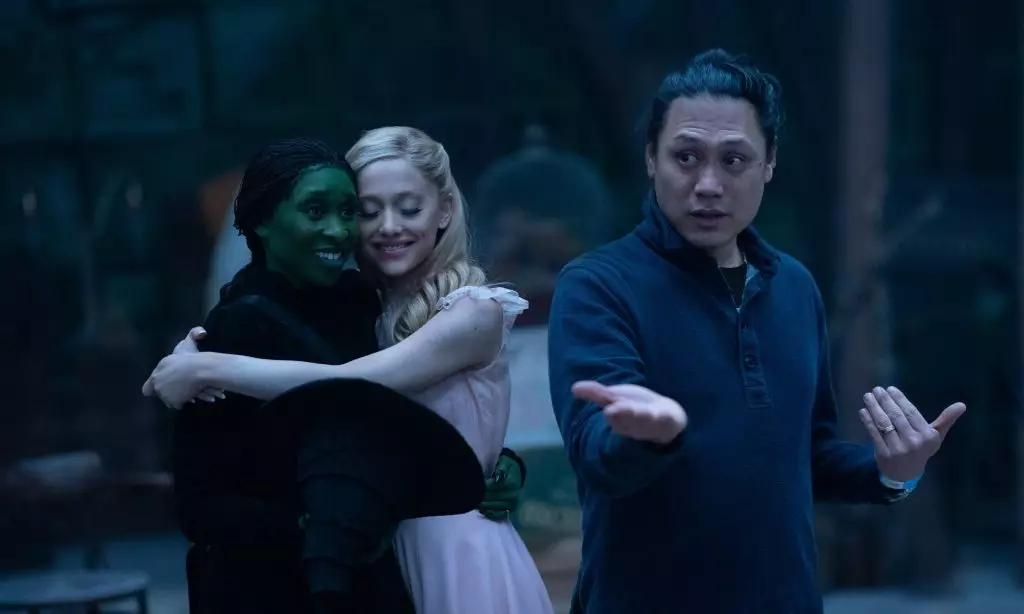The release of Jon M. Chu’s “Wicked” has incited a notable discourse among fans and critics alike regarding its visual aesthetics, particularly its color grading. Some viewers have expressed disappointment over the film’s departure from the vibrant, technicolor explosion that characterized the 1939 classic “The Wizard of Oz.” This nostalgia-driven critique raises interesting questions about the role of visual style in storytelling and the viewer’s expectation in adaptations of beloved tales.
In a conversation with The Globe and Mail, Chu addressed the criticisms surrounding the film’s “desaturated” palette. He emphasized his intent to create a reality for Oz that feels tangible and lived-in, rather than a fantastical dream. By prioritizing realism and emotional depth over artificial vibrancy, Chu’s vision reflects a shift in cinematic storytelling that seeks to enhance character relationships and narrative stakes. His argument indicates that the aesthetics of a film should complement its core themes—here, the complex friendship between Elphaba and Glinda—rather than overshadow them with extravagant visuals.
Chu’s decision to pursue a more muted color scheme reveals an understanding of how setting influences character development. Rather than presenting Oz as an idyllic wonderland, Chu aims to showcase it as a world textured by experience, providing a backdrop that suggests the characters’ struggles and growth. He stated, “I want to feel the dirt. I want to feel the wear and tear of it,” inviting audiences to engage with the world of Oz in a fresh light. This grounding of the narrative helps to underscore the emotional journeys of the characters—representative of deeper themes such as friendship, power, and acceptance.
In stark contrast to the picturesque aesthetic that often accompanies musicals, Chu’s vision attempts to evoke more profound connections with the film’s setting. By allowing the environment to breathe and exist alongside its inhabitants, he crafts a narrative that feels immediate and relatable. In an entertainment landscape saturated with gloss, this commitment to authenticity offers a refreshing standpoint that challenges conventional expectations.
The debate surrounding “Wicked” underscores the varying tastes within the fanbase. Some viewers criticized the film’s subdued coloring, associating it with a lack of dynamism. Social media platforms, particularly X, have become arenas for passionate discussions, with proponents of the film’s aesthetic arguing for its merit while detractors lament its seemingly dull choices. This polarization highlights an important aspect of contemporary cinema—audiences bring their interpretations and emotional attachments to iconic narratives, which can strain the reception of new adaptations.
The contrasting views among fans also reflect a broader conversation about the evolution of visual storytelling. While some seek the nostalgia of technicolor, others appreciate the nuances that come with a more restrained palette. It is vital for filmmakers to navigate these expectations, balancing homage to the past with innovative artistic choices.
Despite the mixed reception of its visual style, “Wicked” has defied expectations at the box office, achieving remarkable milestones. Surpassing numerous records since its release, it has demonstrated that storytelling and strong character arcs can prevail over visual nostalgia. The film has not only achieved the largest global opening for a non-sequel this year but has also led to significant financial successes for its cast and crew.
The adaptation, which delves deeper into the narrative of Elphaba and Glinda, gives audiences a renewed glimpse into their complex dynamics prior to their destinies being set. With a stellar cast including Ariana Grande and Cynthia Erivo, viewers are treated to performances that resonate beyond the surface, supported by Chu’s intentional environmental choices.
Jon M. Chu’s “Wicked” represents a poignant case study in the evolution of visual storytelling. By reimagining the iconic land of Oz through a grounded lens, he challenges both audience expectations and traditional narrative aesthetics. This reinterpretation serves as a testament to the power of storytelling, showcasing the importance of connecting with the characters’ emotional landscapes. As the film continues to make waves at the box office, its place in the contemporary cinematic canon solidifies—reminding us that art, in all its myriad forms, is far richer than mere visuals.


Leave a Reply